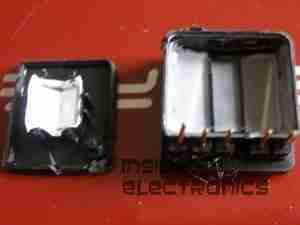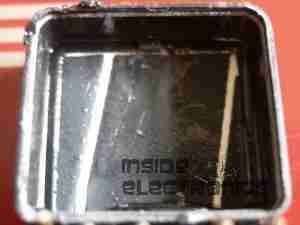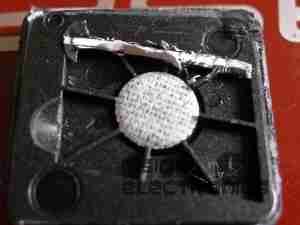
Here is an old electrochemical type carbon monoxide detector cell, from Monox. Hole in the centre is the inlet for the gas under test.
DO NOT TRY THIS AT HOME! Electrochemical cells contain a substantial amount of sulphuric acid, strong enough to cause burns.
This is a type of fuel cell that instead of being designed to produce power, is designed to produce a current that is precisely related to the amount of the target gas (in this case carbon monoxide) in the atmosphere. Measurement of the current gives a measure of the concentration of carbon monoxide in the atmosphere. Essentially the electrochemical cell consists of a container, 2 electrodes, connection wires and an electrolyte – typically sulfuric acid. Carbon monoxide is oxidized at one electrode to carbon dioxide while oxygen is consumed at the other electrode. For carbon monoxide detection, the electrochemical cell has advantages over other technologies in that it has a highly accurate and linear output to carbon monoxide concentration, requires minimal power as it is operated at room temperature, and has a long lifetime (typically commercial available cells now have lifetimes of 5 years or greater). Until recently, the cost of these cells and concerns about their long term reliability had limited uptake of this technology in the marketplace, although these concerns are now largely overcome. This technology is now the dominant technology in USA and Europe.

Rear of unit with connection pins. Hole here is to let oxygen into the cell which permits the redox reaction to take place in the cell when CO is detected, producing a voltage on the output pins.

Cell disassembled. The semi-permeable membrane on the back cover can be seen here, to allow gas into the cell, but not the liquid electrolyte out. Cell with the electrodes is on the right, immersed in sulphuric acid.

Closeup of the electrode structure. Polymer base with a precious metal coating.

Membrane & filter on the test gas input port.

How can I get this type of sensor cells
Hi IA,
I have no idea, these sensors are probably way out of production by now. There are other more modern CO sensors though available from all over the place.
Good job on the tear-down. Nicely explained.
When we heard that they will be discontinued we bought everything we could get our hands on.
None of our competitors have them and quote to replace the entire gas monitor when only the sensors needs to be replaced!
I have 100’s of these although im weary of their shelf-life.
We sell alot of them still and almost never have reliability issues.
Hi,
I would definitely be weary of using old electrochemical sensors! I’m not entirely sure of the aging mechanism of this type of sensor, but there’s an article here which explains a few useful things:
http://www.hazardexonthenet.net/article/128977/Understanding-gas-sensor-lifespan.aspx
I would suspect that sensors as old as these will probably be out of calibration by this point. I would definitely be interested in seeing their reaction to CO after all these years, weighed against their stated response curve in the datasheet.
Cheers
Hi global gas detection,
we need some sensors for our CO detectors. Can you give your contact details?
Thanks
anand
you can reach me at globalgasdetection@gmail.com
The technology for these cells was developed at the former EMI Central Research Laboratories, the labs that invented stereo sound and the CT scanner. One of the big breakthroughs was when a colleague realised that carbon-loaded thermoplastic could make an acid resistant electrical connection through the plastic body, instead of the platinum wire used for previous sensors. That was one of several inventions that made it manufacturable at the right price point. The process for screen printing platinised carbon black on micro-porous PTFE and making it adhere was another key step.